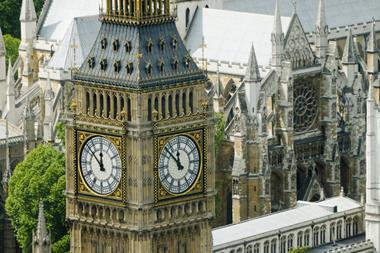Pension funds in the UK have divested corporate bonds in favour of index-linked paper, according to the latest Purple Book.
The Purple Book, the most authoritative set of data on UK defined benefit (DB) schemes published by the Pensions Regulator (TPR) and Pension Protection Fund (PPF), also found an increased interest in alternative assets such as hedge funds – for the first time accounting for more than 5% of the investment universe.
According to the data from the eighth publication, exposure to equities also continued to fall, and UK-listed shares declined further, accounting for 38.7% of portfolios – down from 40% in 2012.
TPR also noted an increased exposure to government bonds for the first time since 2008 when it began distinguishing between the different types of fixed income.
“Within total Gilts and fixed interest, the corporate fixed interest securities’ allocation decreased from 44.8% in 2012 to 40.6% in 2013,” the Purple Book said.
“Meanwhile, the proportion of government fixed interest rose from 17.7% to 18.5%. The balance of holdings in index-linked rose to 40.9% from 37.5% in 2012.”
The level of investment to property remained largely unchanged, falling 0.2 percentage points from 2012 to 4.7%.
| 2013 (%) | 2012 (%) | |
|---|---|---|
| Equities | 35.10 | 38.50 |
| Fixed interest/Gilts | 44.80 | 43.20 |
| Insurance policies | 0.10 | 0.20 |
| Cash/Deposits | 6.70 | 5.10 |
| Property | 4.70 | 4.90 |
| Other investments | 3.50 | 3.60 |
| Hedge funds | 5.20 | 4.50 |
| (Source: 2013 Purple Book, page 56) | ||
However, DB funds increased the amount of assets held in cash and deposits to an all-time high of 6.7%, an almost threefold increase since the first Purple Book was published in 2006 and up by 1.6 percentage points year on year.
Hedge funds also attracted a growing amount of capital, breaking the 5% threshold for the first time the asset class was separately measured in 2009.
The number of company guarantees employed as contingent assets also fell over 2012’s total level of 900 after stricter standards were introduced.
However, contingent assets employing real estate or granting a security over company cash holdings rose slightly.
Consultancy Towers Watson also noted that the report estimated a £700bn shortfall between assets under management by DB funds and their achieving a full insurance buyout, resulting in a buyout funding level of 61% compared with 84% otherwise.
But John Ball, head of UK pensions at the consultancy, said the £700bn figure was only an indicative number.
“There is not the capacity for insurers to swallow £1.8trn of liabilities in one go rather than just nibbling away a few billion each year,” he said.
“It does underline that, for most employers, getting all pension liabilities completely off the balance sheet would still require a significant cash injection.
“Buyout prices have come down over the past few months, but this will only have made a small dent in these deficits.”









.jpg)








No comments yet